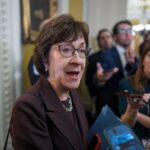

The Federal Reserve officials signaled they still expect to cut rates three times this year but continued to say that they will wait to start cutting until they have more convincing evidence of progress on inflation.
“The Committee does not expect it will be appropriate to reduce the target range until it has gained greater confidence that inflation is moving sustainably toward 2 percent,” the Fed said in a statement released at the conclusion of its two-day monetary policy meeting.
A big question going into the Fed meeting was how many cuts central bankers would indicate they are expecting this year. At the December meeting, the last time they released projections, officials forecast three-quarters of a point of rate cuts this year. The new projections leave that forecast unchanged despite stronger-than-expected growth, a solid labor market, and hotter-than-expected inflation.
The central bank has kept its benchmark federal funds rate targeted at a range between 5.25 percent and 5.5 percent since July 2023. The Fed said at its January meeting that it was awaiting more convincing evidence that the downturn in inflation seen last year will persist.
It repeated that language on Wednesday, indicating that it continues to await evidence that inflation is coming down to its two percent target.
The Fed sees the economy as fundamentally strong.
“Recent indicators suggest that economic activity has been expanding at a solid pace. Job gains have remained strong, and the unemployment rate has remained low. Inflation has eased over the past year but remains elevated,” the Fed said.
Although officials left their expectations for rate cuts this year unchanged, their projections showed that they expect more growth, more core inflation, and less unemployment this year and over the following two years. The longer run expectations for growth, unemployment, and inflation, however, were all unchanged.
The projections of the fed funds rate in the future also moved up. The policy rate is expected to fall to 3.9 percent by the end of next year, up from 3.6 percent at the December meeting. The following year, it is seen as declining to 3.1 percent, above the 2.9 percent penciled last time. The longer-run estimation of the Fed funds rate increased to 2.6 percent, the first time this has risen above 2.5 percent since 2019.
Fed officials have acknowledged that they were late to act on inflation two years ago, mistakenly believing for most of 2021 that upward pricing pressure would dissipate as transitory factors related to the emergence from the pandemic receded. Beginning in March of 2022, the Fed raised rates aggressively
Last year, the Fed signaled that it was done raising rates and expected to be cut rates this year. Many analysts and investors initially expected the Fed would cut early this year but the Fed pushed back on those expectations. In a statement following the January meeting, the Fed made it clear it would not cut at the following meeting in March.
Several Fed officials have said since then that the strength of the economy means the Fed can be patient when it comes to cutting rates. Historically, the Fed has been prompted to cut rates to keep unemployment from rising too high or economic growth from slowing too much. This year, both the labor market and the broader economy have been stronger than expected.





